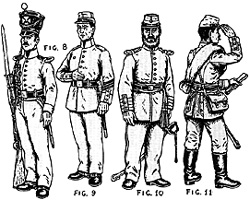Imperial Brazilian Uniforms
During the
War of the Triple Alliance
Part 1: Line Infantry
By C. A. Norman
| |
CACADORES:
Fig.8. Cacador, 8th Battalion, Winter Full Dress, c. 1865: Black shako with bronzed Maltese Cross plate, national cocade above, black cords and flounders, green pompom. Very dark green coatee with red collar and round cuffs, dark green skirt turnbacks, bronzed buttons, stiff black shoulder-straps with brass crescents, resembling epaulets. Dark green trousers over black gaiters. Black waistbelt with brass plate, white gloves, "Carbine" with black strap and brass-hilted sabre bayonet. The breaststrap with brush and needle is also of black leather, but is almost hidden by the shako cords and flounders which attach to the same button on the right breast. Fig.9 Cacador "Furriel", 8th battalion, "Second" or Service Uniform, c. 1865: Dark green kepi with red band and vertical seam piping, black chinstrap. Dark green tunic with red collar patches and 3-button cuff flaps; dark green collar, shoulder-straps and cuffs (the latter edged with a black piping on the top), bronzed buttons. Three black diagonal rank stripes backed with red on the lower left sleeve. White trousers worn with black gaiters, black waistbelt with brass plate and sliding bars. NCO's rank insignia also conformed to the regulations of 1852, consisting of diagonal rank stripes on the lower left sleeve only, running from seam to seam. In theory these stripes were to be of branch-coloured wool, though the range of unit facing colours in use prior to 1866 frequently led to variations (regulations were tightened up in this regard after 1866), generally backed/edged with a contrasting colour. The ranking system was as follows:
Cabo {Corporal): 2 stripes. Furriel (Quartermaster): 3 stripes. 2 degree Sargento (Second Sargeant): 4 stripes. 1 degree Sargento (First Sargeant): 5 stripes (this rank was sometimes referred to as "Sargento Mor" / Sargeant Major). Fig.10 Colonel of Cacadores, Undress Uniform, c. l866-70: Dark blue kepi with yellow band and vertical piping, black chinstrap, small national cocade on the front. Dark blue tunic with dark blue collar, cuffs and cuff flaps, all edged with yellow piping, yellow front piping, gilt buttons and gold cuff rank lace. Dark blue shoulder-straps edged with yellow piping and gilt metal crescents. Dark blue trousers with yellow side piping. Black waistbelt with gilt plate, worn over an (officially} crimson sash with gold lace knot and crimson tassels. White gloves, black sabre knot. Fig.11 Cacadores Ensign, Campaign Dress, c. 1866-70: Kepi with white cotton cover, black chinstrap (these kepis seem to have been some-times made entirely of white cotton, with no woolen backing; entirely non-regulation, needless to say). Entirely dark blue tunic trimmed with yellow piping, including the rear skirt slash and irregularly shaped 3-button rear pocket flaps, gilt buttons and 1 gold cuff lace just below the yellow piping, dark blue epaulet loops on the shoulder (the "epaulets" not being normally worn on campaign). White cotton or linen trousers tucked into black marching boots, black waistbelt over crimson sash, brown leather bag for personal effects on the left hip, dark blue greatcoat or mantle in a roll over the right shoulder. Illustrations
Figures 5 - 7: Two Fusiliers, Capt. Figures 8 - 11: Two Cacadores, Col., Ensign Figures 12 -14: Three Cacadores on campaign Back to Brazilian Uniforms Part 1 Back to Table of Contents -- El Dorado Vol VII No. 1 © Copyright 1996 by The South and Central Military Historians Society This article appears in MagWeb (Magazine Web) on the Internet World Wide Web. |